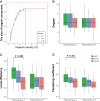Structural Network Topology Reveals Higher Brain Resilience in Individuals with Preclinical Alzheimer's Disease
- PMID: 37551987
- PMCID: PMC10771874
- DOI: 10.1089/brain.2023.0013
Structural Network Topology Reveals Higher Brain Resilience in Individuals with Preclinical Alzheimer's Disease
Abstract
Introduction: The diagnosis of Alzheimer's disease (AD) requires the presence of amyloid and tau pathology, but it remains unclear how they affect the structural network in the pre-clinical stage. We aimed to assess differences in topological properties in cognitively normal (CN) individuals with varying levels of amyloid and tau pathology, as well as their association with AD pathology burden. Methods: A total of 68 CN individuals were included and stratified by normal/abnormal (-/+) amyloid (A) and tau (T) status based on positron emission tomography results, yielding three groups: A-T- (n = 19), A+T- (n = 28), and A+T+ (n = 21). Topological properties were measured from structural connectivity. Group differences and correlations with A and T were evaluated. Results: Compared with the A-T- group, the A+T+ group exhibited changes in the structural network topology. At the global level, higher assortativity was shown in the A+T+ group and was correlated with greater tau burden (r = 0.29, p = 0.02), while no difference in global efficiency was found across the three groups. At the local level, the A+T+ group showed disrupted topological properties in the left hippocampus compared with the A-T- group, characterized by lower local efficiency (p < 0.01) and a lower clustering coefficient (p = 0.014). Conclusions: The increased linkage in the higher level architecture of the white matter network reflected by assortativity may indicate increased brain resilience in the early pathological state. Our results encourage further investigation of the topological properties of the structural network in pre-clinical AD.
Keywords: Alzheimer's disease; assortativity; diffusion tensor imaging; graph theory; structural connectivity; tractography.
Conflict of interest statement
No competing financial interests exist.
Figures




Similar articles
-
Diffusion Changes in Hippocampal Cingulum in Early Biologically Defined Alzheimer's Disease.J Alzheimers Dis. 2023;91(3):1007-1017. doi: 10.3233/JAD-220671. J Alzheimers Dis. 2023. PMID: 36530082
-
Tau-related grey matter network breakdown across the Alzheimer's disease continuum.Alzheimers Res Ther. 2021 Aug 13;13(1):138. doi: 10.1186/s13195-021-00876-7. Alzheimers Res Ther. 2021. PMID: 34389066 Free PMC article.
-
Nonlinear changes in delayed functional network topology in Alzheimer's disease: relationship with amyloid and tau pathology.Alzheimers Res Ther. 2023 Jun 16;15(1):112. doi: 10.1186/s13195-023-01252-3. Alzheimers Res Ther. 2023. PMID: 37328909 Free PMC article.
-
White matter hyperintensities are higher among early-onset Alzheimer's disease participants than their cognitively normal and early-onset nonAD peers: Longitudinal Early-onset Alzheimer's Disease Study (LEADS).Alzheimers Dement. 2023 Nov;19 Suppl 9(Suppl 9):S89-S97. doi: 10.1002/alz.13402. Epub 2023 Jul 25. Alzheimers Dement. 2023. PMID: 37491599 Free PMC article. Review.
-
The Effects of Amyloid and Tau on Functional Network Connectivity in Older Populations.Brain Connect. 2021 Oct;11(8):599-612. doi: 10.1089/brain.2020.0902. Epub 2021 May 17. Brain Connect. 2021. PMID: 33813858 Review.
References
-
- Bahrami M, Hossein-Zadeh G-A. Assortativity Changes in Alzheimer's Diesease: A Resting-State FMRI Study. In: 2015 23rd Iranian Conference on Electrical Engineering. IEEE: New York, NY; 2015; pp. 141–144.
Publication types
MeSH terms
Grants and funding
LinkOut - more resources
Full Text Sources
Medical


